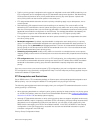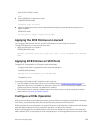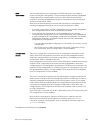Committed and peak bandwidth is in megabits per second. The range is from 0 to 40000.
Committed and peak burst size is in kilobytes. Default is 50. The range is from 0 to 10000.
3. Configure the 802.1p priorities for the traffic on which you want to apply an ETS output policy.
PRIORITY-GROUP mode
priority-list value
The range is from 0 to 7.
The default is none.
Separate priority values with a comma. Specify a priority range with a dash. For example, priority-list
3,5-7.
4. Exit priority-group configuration mode.
PRIORITY-GROUP mode
exit
5. Repeat Steps 1 to 4 to configure all remaining dot1p priorities in an ETS priority group.
6. Specify the dot1p priority-to-priority group mapping for each priority.
priority-pgid dot1p0_group_num dot1p1_group_num ...dot1p7_group_num
Priority group range is from 0 to 7. All priorities that map to the same queue must be in the same
priority group.
Leave a space between each priority group number. For example: priority-pgid 0 0 0 1 2 4 4 4 in
which priority group 0 maps to dot1p priorities 0, 1, and 2; priority group 1 maps to dot1p priority 3;
priority group 2 maps to dot1p priority 4; priority group 4 maps to dot1p priorities 5, 6, and 7.
Dell Networking OS Behavior: A priority group consists of 802.1p priority values that are grouped for
similar bandwidth allocation and scheduling, and that share latency and loss requirements. All 802.1p
priorities mapped to the same queue must be in the same priority group.
Configure all 802.1p priorities in priority groups associated with an ETS output policy. You can assign
each dot1p priority to only one priority group.
By default, all 802.1p priorities are grouped in priority group 0 and 100% of the port bandwidth is assigned
to priority group 0. The complete bandwidth is equally assigned to each priority class so that each class
has 12 to 13%.
The maximum number of priority groups supported in ETS output policies on an interface is equal to the
number of data queues (4) on the port. The 802.1p priorities in a priority group can map to multiple
queues.
If you configure more than one priority queue as strict priority or more than one priority group as strict
priority, the higher numbered priority queue is given preference when scheduling data traffic.
ETS Operation with DCBx
The following section describes DCBx negotiation with peer ETS devices.
In DCBx negotiation with peer ETS devices, ETS configuration is handled as follows:
• ETS TLVs are supported in DCBx versions CIN, CEE, and IEEE2.5.
Data Center Bridging (DCB)
257


















